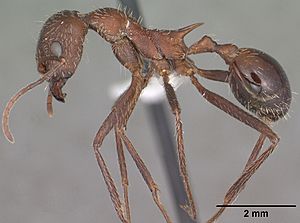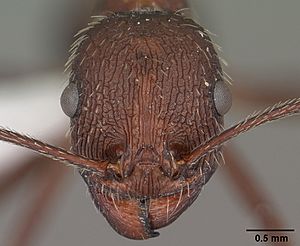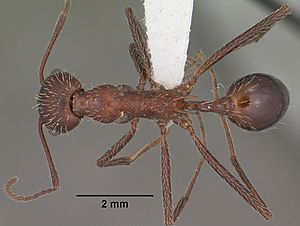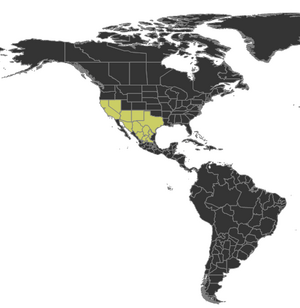Desert harvester ant facts for kids
Quick facts for kids Novomessor albisetosus |
|
|---|---|
 |
|
| N. albisetosus worker specimen | |
| Scientific classification | |
| Kingdom: | |
| Phylum: | |
| Class: | |
| Order: | |
| Family: | |
| Subfamily: |
Myrmicinae
|
| Tribe: |
Stenammini
|
| Genus: | |
| Species: |
N. albisetosus
|
| Binomial name | |
| Novomessor albisetosus Mayr, 1886
|
|
| Synonyms | |
|
|
The Novomessor albisetosus, also known as the desert harvester ant, is a type of ant. You can find these ants in the United States and Mexico. It belongs to a group of ants called Novomessor.
This ant is medium-sized, usually about 6 to 8.5 millimeters (0.2 to 0.3 in) long. It has a reddish-brown body. You can tell it apart from other Novomessor ants because its head is shorter and its eyes are almost parallel.
N. albisetosus lives in deserts and woodlands. They build their nests underground or under rocks. These ants are busy in the morning and evening. They look for food like insect pieces, plant parts, and fruit. Sometimes they work together to carry big food items back to their nest. Other ants, like army ants, sometimes hunt them.
Contents
About the Desert Harvester Ant
The desert harvester ant, Novomessor albisetosus, was first described by an Austrian scientist named Gustav Mayr in 1886. He first called it Aphaenogaster albisetosa. Over the years, scientists have changed how they classify this ant as they learned more.
In 1915, another scientist named Carlo Emery put this ant into a new group called Novomessor. Later, in 2015, a new study showed that Novomessor ants are genetically different from Aphaenogaster ants. This study confirmed that Novomessor is its own special group.
What Does N. albisetosus Look Like?
N. albisetosus is a medium-sized ant. It measures about 6 to 8.5 millimeters (0.2 to 0.3 in) long. Its body is a rust-red color. The legs are reddish-brown, and its waist (called the petiole) and back part of its body (abdomen) are brownish-black. The first part of its abdomen is brownish-yellow.
The ant's head is quite long, longer than it is wide. It has three large teeth on its mouthparts, which are called mandibles.
Baby ants, called larvae, are about 6.6 millimeters (0.3 in) long. They have short, sparse hairs on their bodies and heads. Their mouthparts are small.
You can tell N. albisetosus apart from its close relatives, like Novomessor cockerelli.
- The head of N. albisetosus is shorter than N. cockerelli's.
- The spines on its body are more bent downwards.
- Its body is also more solid and less see-through.
- It has whitish-yellow hairs all over its body.
Queen ants of N. albisetosus also have a slightly longer head than wide. Their body is shorter and higher compared to N. cockerelli queens.
Where Do These Ants Live?
N. albisetosus lives in Mexico and the southwestern United States. In the U.S., you can find them in Texas, New Mexico, and Arizona. In Mexico, they live in states like Chihuahua, Durango, and Sonora.
These ants are not as common as N. cockerelli. They prefer warmer areas and are not found in high mountain regions. Their nests are usually found at heights between 2,146 and 5,840 ft (654 and 1,780 m) above sea level.
Their homes can be in deserts, juniper woodlands, or even pine-oak forests. They build their nests underground or under large stones. The entrances to their nests are usually rough and about 3 to 4 in (7.6 to 10.2 cm) wide. They often build a disc of gravel and soil around the entrance.
How Do Desert Harvester Ants Behave?
N. albisetosus ants are active during the day and night. However, they do not look for food in the middle of the night or when it's too hot in the middle of the day. They are most active when the temperature is between 68 °F (20 °C) and 104 °F (40 °C).
These ants move slowly. Even though they were once thought to forage alone, they will work together to carry large food items back to their nest. They can even follow the scent trails left by N. cockerelli ants.
They eat many different things, including:
- Insect pieces
- Seeds
- Plant parts
- Fruit
They don't seem to prefer seeds over other foods. If they find a piece of food that's too big to carry, they make a special sound by rubbing body parts together. This sound tells other ants nearby to come help.
These ants are very protective of their nests. They will fight off other ants that try to enter. Army ants are known to hunt N. albisetosus.
Mating flights, where new queens and males fly to find mates, start in June. Adult worker ants are considered "grown up" when they spend more than half their time outside the nest.
See also
 In Spanish: Messor pergandei para niños
In Spanish: Messor pergandei para niños




